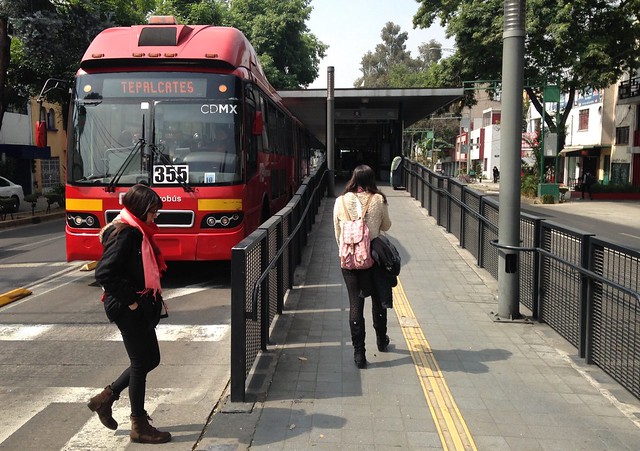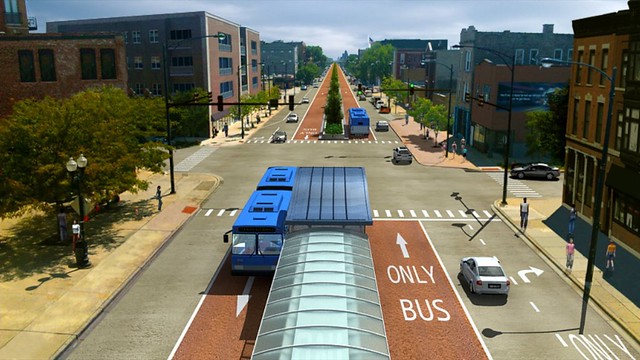
[The Chicago Reader recently launched a weekly transportation column written by Streetsblog Chicago editorJohn Greenfield. This partnership allows Streetsblog to extend the reach of our livable streets advocacy. We syndicate a portion of the column after it comes out online; you can read the remainder on the Reader’s website or in print. The paper hits the streets on Thursdays.]
With a metropolitan population of 21 million, the largest of any city in the western hemisphere, Mexico City is often associated with overcrowding, air pollution, and traffic jams. But when I visited for the first time last month, I found it to be a place of beautiful Spanish Colonial and Art Deco architecture, intriguing museums, tasty chow, and warm-hearted people.
The Distrito Federal, or D.F., as Mexico City is called in Spanish, also has an excellent public transportation system. Its Metro is the second-busiest rapid transit system in North America, after New York City’s. While the train cars can be scary-packed during rush hour, they crisscross a large portion of the city and provide a fast, smooth ride compared to Chicago’s 'L' trains.
And over the last decade, Mexico City has supplemented its subway by developing one of the world’s leading bus rapid transit networks, the Metrobús system, which debuted on Avenida de los Insurgentes in 2005. With dedicated bus lanes and raised-platform stations, the system provides subway-like commute speeds at a small fraction of the infrastructure cost of underground transit. The sixth route opened in mid-January, and a seventh line is slated for completion later this year.
As a wide, mostly straight roadway that runs the length of the city and intersects with many rail lines, Insurgentes is not so different from Chicago’s Ashland Avenue, where Mayor Emanuel has proposed building our city’s first full-on bus rapid transit corridor. As such, there’s a lot that we can learn from Mexico City’s experiences with Metrobús.
The road to full-fledged BRT in Chicago has been anything but smooth. In 2012 the CTA rolled out the Jeffery Jump, a “BRT-lite” route serving the south side, funded by an $11 million Federal Transit Administration grant. It features dedicated lanes on a mere two miles of its 16-mile route, and only during rush hour.
That year, the city also held a series of public meetings on what would become the plan for a robust bus rapid transit system on Ashland between 95th and Irving Park, with dedicated lanes for the entire route, center-running buses, median stations, and other time-saving features. This $160 million project has been highly controversial, because it would involve converting two of the street’s four travel lanes into bus-only lanes, and eliminating most left turns from Ashland for drivers.
Aldermen George Cardenas and Scott Waguespack were critical of the proposal. Randolph/Fulton Market Association director Roger Romanelli formed the Ashland-Western Coalition, an anti-BRT group, in an effort to derail the plan.
By August 2015, when Emanuel announced the return of regular express bus service on Ashland and Western, it was clear that the Ashland BRT plan had been back-burnered. "It's way off in the future," the mayor said. “The only bus rapid transit I'm focused on right now is… in the Central Business District.”
Emanuel was referring to the $41 million Loop Link corridor, which opened in December, mostly on Washington and Madison. The route features red dedicated lanes and raised-platform stations, and serves six bus routes. So far the system’s performance has been underwhelming.
While it was supposed to have doubled cross-Loop bus speeds from the previous, glacial, 3 mph rush-hour pace, that hasn’t happened yet. Last week, an 0.8-mile trip I took on Madison between Michigan and Canal took 11 minutes.
Due to a horrific traffic jam on the Washington bridge, my eastbound return trip took a whopping 15 minutes. In addition, CTA spokesman Jeff Tolman confirmed last week that drivers are still required to creep cautiously towards the stations at 3 mph in order to avoid striking passengers with their rearview mirrors.
During my trip to the D.F., I was impressed by how well the Metrobús system functions. To access the buses, you cross the street to the median stations, which double as pedestrian islands. After buying a pass from a kiosk, you swipe your card at a turnstile–each ride costs six pesos, or about $0.30.





